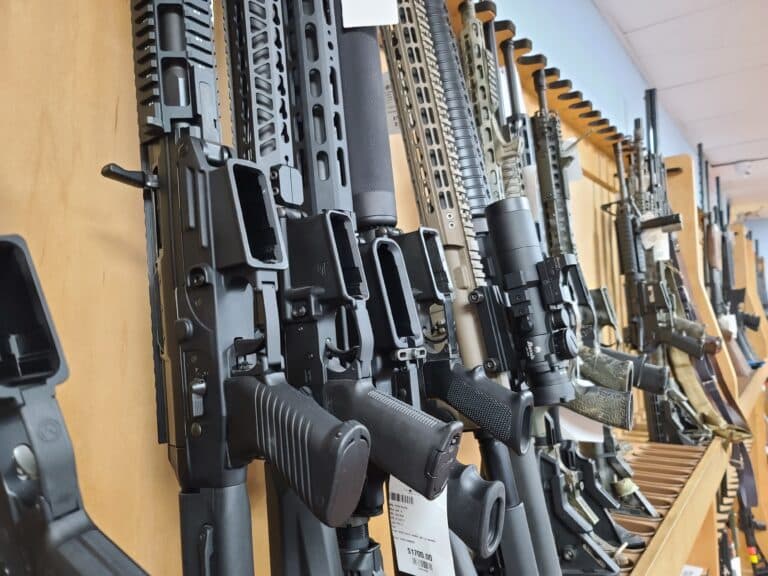An increasingly common theme among judges who uphold hardware bans is the claim that “assault weapons” and “large capacity” magazines are not commonly used. Now, a judge who disagrees with those holdings has officially taken those claims head-on.
United States District Court Judge Roger Benitez ruled on Thursday that California’s ban on AR-15s and other so-called “assault weapons” violates the Second Amendment. He did so primarily because the State’s ban was an improper outlier in the country’s historical tradition of gun regulation. But he also devoted an entire section in the latter half of his 79-page opinion to address what he called “new arguments” in support of such hardware bans—namely that the arms they cover are not “commonly owned” or “in common use.”
“A new twist on an old argument is that standard AR-15-type rifles are not commonly owned by law-abiding persons for lawful purposes,” Benitez wrote. “An expert witness for the State suggests that although such rifles number more than 24.4 million among Americans, a smaller number of people (7.9 million) might own most of them.”
Judge Benitez countered by arguing that the State’s own estimate was more than sufficient to meet the threshold for commonality. He said the Supreme Court’s 2016 holding that the Second Amendment protects stun guns supported that conclusion.
“Seven million nine hundred thousand persons is still a large number of citizens choosing to own AR-15 type firearms,” he said. “When the Supreme Court vacated Caetano’s conviction for mere possession of a stun gun, 200,000 owners of stun guns was all it took.”
Benitez then turned to the claim that a rifle must actually be fired, specifically in a defensive gun use situation, to qualify as an arm “in common use.”
“The State suggests that standard AR-15-type rifles might be commonly owned, but are not used for self-defense,” he wrote. “The State says that there is no evidence that firearms equipped with the prohibited accessories or semiautomatic centerfire rifles of less than 30 inches in length are ‘commonly used’ for self-defense.”
This argument has gained prominence in the aftermath of the Supreme Court’s New York State Rifle and Pistol Association v. Bruen decision. Nearly every federal judge to uphold an assault weapon or magazine ban post-Bruen has raised the question of guns and magazines actually being utilized by citizens in self-defense situations–often even requiring that more defensive shots be fired than the mag limit to count towards the analysis.
“This Court finds that an individual’s subjective intent in purchasing a firearm or firearm accessory for self-defense, while relevant, also cannot be dispositive in assessing whether a firearm or firearm accessory is in common use for self-defense,” U.S. District Judge Karin Immergut wrote in an opinion upholding Oregon’s magazine ban. “The objective evidence shows that having more rounds does not facilitate self-defense because those rounds are rarely, if ever, used.”
Some have even based their rulings entirely on this question.
“Plaintiffs’ proposed ownership of assault weapons and LCMs is not protected by the Second Amendment because they have not demonstrated that the specific assault weapons and LCMs in the Challenged Statutes are commonly sought out, purchased, and used for self-defense,” Judge Janet Bond Arterton wrote in Flanigan v. Lamont, a case challenging Connecticut’s hardware bans. “In the absence of persuasive evidence that the assault weapons or LCMs listed in the statutes are commonly used or are particularly suitable for self-defense, Plaintiffs have failed to carry their burden.”
Benitez, however, dismissed the argument as little more than “a word game.” He said California failed to provide evidence that AR-15s are not commonly used, which he said was the government’s burden to prove.
“The burden is on the government to prove that remarkable claim,” he wrote. “It does not take a Nobel laureate to figure out that if Americans own 400 million guns and 400 million gun crimes are not being committed, that Americans are using their guns for something other than crime. If Americans own 24.4 million AR-15s and 24.4 million gun crimes are not being committed with AR-15s, Americans must be using them for lawful purposes.”
He also cited other lawful uses for AR-15s beyond defense, like “hunting or sport or target practice.” But even under the narrow parameters of self-defense purposes, Benitez likened the “use” of AR-15s to the way most people use other precautionary safety equipment.
“Probably the vast majority of Americans that own guns keep them and use them for self-defense the same way that a driver puts on a seat belt in the case of a collision,” he wrote. “Though collisions rarely happen, the seat belt is used for protection and to be ready for the unexpected collision. A reserve canopy is being used on a parachute jump, although it is not deployed, in case the main parachute fails. A cell phone in one’s pocket is being used when waiting for a telephone call or when one might need to make a call. An AR-15 under one’s bed at night is being used for self-defense even when the night is quiet. A person may happily live a lifetime without having to fire their gun in self-defense. But that is not to say that such a person does not use their gun for self-defense when he or she keeps it under the bed with a hope and a prayer that it never has to be fired.”
Finally, he argued that appeals to empirical evidence purporting to show specific arms being used in defensive encounters—the quality of which he called into question for being reliant on hearsay and incomplete news reports—did not comport with how the Supreme Court arrived at its Heller decision striking down handgun bans.
“If the test was concerned with the actual firing of a weapon, the Heller court would have looked at statistical averages about how often handguns were fired for self-defense,” Benitez wrote. “The statistic was never mentioned.”






